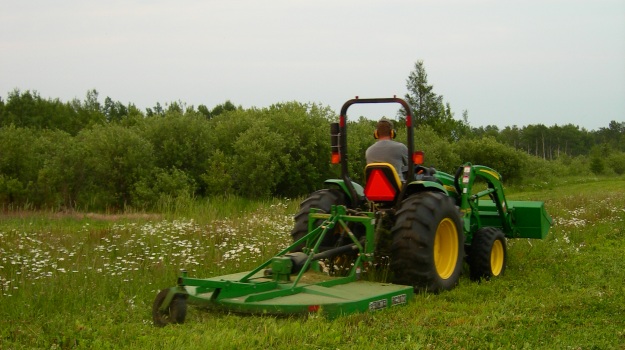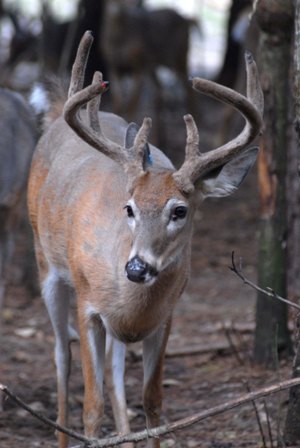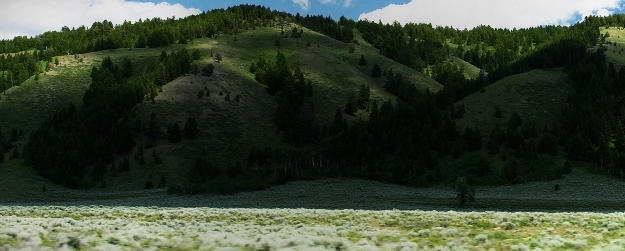
About all outdoorsmen have things they’d rather do on weekends than mow the grass on green fields planted for wildlife to increase the amount of food to make deer and turkeys easier to find and take. But in most sections of the country, except for the far north, most wildlife managers already have started mowing their green fields before June. Most deer hunters and land managers who plant food for wildlife in the Deep South probably already have started mowing in mid-April to early May. By mid-May the clover starts heading out (putting on blooms to create seed). You’ll want to mow the tops of that clover to keep the clover from heading out and keep them from spreading. When mowing perennials like clover, alfalfa and chicory, you don’t want to mow as often as you mow your lawn. You just want to cut the top 1- 2 inches of that plant (1/3 the height of that plant). Mowing will encourage the plants to have stronger root structures and more growth on the bottoms of the plants, putting out more runners to create more root systems for healthier food plots that make more tonnage for wildlife.
In some areas, you may need to mow 1-3 times during the spring and summer months, but in some parts of the country, you may have to mow these perennials only one time, depending on how heavy those green fields are getting browsed during the spring and summer. With a 1-acre food plot and 100 acres of timber land, you may not have to ever mow your food plots, because the deer will browse heavily there and keep it mowed down for you. But if you live in other sections of the country where there’s more food available besides your green fields, once again, you may have to mow two to three times in the spring and summer. Many wildlife managers ask us when and how much to fertilize. Generally speaking, the soil test that you take in the spring of the year before you plant will answer this question for you. You’ll usually fertilize and lime before planting. But you also may want to fertilize late in the summer, just before archery season starts, to have a lush green food plot just before hunting season.
 When the nights become cooler and more rains occur in the fall is a good time to begin broadcasting fertilizer. Again, rely on your soil test to tell you how much fertilizer to put out. Mossy Oak BioLogic offers a soil-test program. Once we receive your soil sample, within 24-36 hours we can mail or email you the results of the soil test with recommendations on any or no fertilizer or lime your fields need. The soil test we supply at Mossy Oak BioLogic also gives you the results of the micro nutrients that most soil tests don’t provide. Most bags of fertilizer contain nitrogen, potassium and phosphorous, but if your soil needs micro nutrients, you generally won’t have them in most bagged fertilizers. If micro nutrients are needed to make your soil be as fertile as possible, you may have to order a specific fertilizer with those missing micro nutrients added to the fertilizer.
When the nights become cooler and more rains occur in the fall is a good time to begin broadcasting fertilizer. Again, rely on your soil test to tell you how much fertilizer to put out. Mossy Oak BioLogic offers a soil-test program. Once we receive your soil sample, within 24-36 hours we can mail or email you the results of the soil test with recommendations on any or no fertilizer or lime your fields need. The soil test we supply at Mossy Oak BioLogic also gives you the results of the micro nutrients that most soil tests don’t provide. Most bags of fertilizer contain nitrogen, potassium and phosphorous, but if your soil needs micro nutrients, you generally won’t have them in most bagged fertilizers. If micro nutrients are needed to make your soil be as fertile as possible, you may have to order a specific fertilizer with those missing micro nutrients added to the fertilizer.
A couple of years ago Mossy Oak BioLogic introduced the water soluble M.E.E.N. Green fertilizer that can be added to spray tanks when you spray herbicides to kill weeds. The M.E.E.N. Green fertilizer encourages the weeds to intake more herbicide, producing a better weed kill when you spray and adding a full crop of those micro nutrients plus nitrogen, potassium and phosphorous. M.E.E.N. Green fertilizer comes in a 5-pound bag that if you add to the Weed Reaper Herbicide kills weeds and fertilizes green field plantings in one application.
Some hunters just before bow season use hand sprayers, mix up the M.E.E.N. Green fertilizer and spray it on the green field where they plan to hang their hunting stands. That way these plants will be the best-tasting plants in the green field and tend to attract more deer to that specific spot (within bow range of the tree stand hunter). Too, some hunters will spray a 20-30 yard semicircle on the edges of their green fields where they set up their tree stands - another effective way to get deer in close enough to be taken with their bows. M.E.E.N. Green fertilizer costs about $40 per acre, so if you use it to sweeten-up the plants around your bow stand, one bag of M.E.E.N. Green fertilizer used two-three times in the early fall may be the difference in getting a bow shot or not.
Day 1: The Importance of Spraying Now to Increase the Life and the Productiveness of Green Field Plantings
Tomorrow: What about the Birds?






























